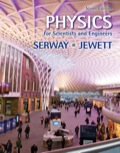
Concept explainers
(a)
The rms speed for a particle of diameter
(a)
Answer to Problem 21.61AP
The rms speed for a particle of diameter
Explanation of Solution
Given info: Density of spherical particle is
Write the expression for the rms speed:
Here,
Write the formula for mass:
Here,
Write the formula for volume of spherical particle:
It is given that diameter of spherical particle is
Substitute
Substitute
Since, boltzmann’s constant is
Substitute
Conclusion:
Therefore, the rms speed for a particle of diameter
(b)
The time interval for particle to move a distance equal to its own diameter.
(b)
Answer to Problem 21.61AP
The time interval for particle to move a distance equal to its own diameter is
Explanation of Solution
Given info: Density of spherical particle is
Write the expression for the time interval related to rms:
Here,
Since particle is moving equal to its diameter. So, the distance travelled by the particles is
Substitute
Conclusion:
Therefore, the time interval for particle to move a distance equal to its own diameter is
(c)
The rms speed and the time interval for a particle of diameter
(c)
Answer to Problem 21.61AP
The rms speed for a particle of diameter
Explanation of Solution
Given info: Density of spherical particle is
The rms speed for a particle of diameter
Substitute
The time interval for a particle of diameter
Substitute
Conclusion:
Therefore, the rms speed for a particle of diameter
(d)
The rms speed and the time interval for a sphere of
(d)
Answer to Problem 21.61AP
The rms speed for a sphere of
Explanation of Solution
Given info: Density of spherical particle is
Write the expression for the rms speed:
Here,
Substitute
Thus, the rms speed of the partical is
Write the formaula for volume in relation to mass and density.
Here,
Substitute
Write the formula for the volume of sphere:
Here,
Rearrange above equation for
Substitute
Write the expression for the time interval related to rms:
Substitute
Substitute
Conclusion:
Therefore, the rms speed for a sphere of
Want to see more full solutions like this?
Chapter 21 Solutions
EBK PHYSICS FOR SCIENTISTS AND ENGINEER
- Four capacitors are connected as shown in the figure below. (Let C = 12.0 µF.) A circuit consists of four capacitors. It begins at point a before the wire splits in two directions. On the upper split, there is a capacitor C followed by a 3.00 µF capacitor. On the lower split, there is a 6.00 µF capacitor. The two splits reconnect and are followed by a 20.0 µF capacitor, which is then followed by point b. (a) Find the equivalent capacitance between points a and b. µF(b) Calculate the charge on each capacitor, taking ΔVab = 16.0 V. 20.0 µF capacitor µC 6.00 µF capacitor µC 3.00 µF capacitor µC capacitor C µCarrow_forwardTwo conductors having net charges of +14.0 µC and -14.0 µC have a potential difference of 14.0 V between them. (a) Determine the capacitance of the system. F (b) What is the potential difference between the two conductors if the charges on each are increased to +196.0 µC and -196.0 µC? Varrow_forwardPlease see the attached image and answer the set of questions with proof.arrow_forward
- How, Please type the whole transcript correctly using comma and periods as needed. I have uploaded the picture of a video on YouTube. Thanks,arrow_forwardA spectra is a graph that has amplitude on the Y-axis and frequency on the X-axis. A harmonic spectra simply draws a vertical line at each frequency that a harmonic would be produced. The height of the line indicates the amplitude at which that harmonic would be produced. If the Fo of a sound is 125 Hz, please sketch a spectra (amplitude on the Y axis, frequency on the X axis) of the harmonic series up to the 4th harmonic. Include actual values on Y and X axis.arrow_forwardSketch a sign wave depicting 3 seconds of wave activity for a 5 Hz tone.arrow_forward
- Sketch a sine wave depicting 3 seconds of wave activity for a 5 Hz tone.arrow_forwardThe drawing shows two long, straight wires that are suspended from the ceiling. The mass per unit length of each wire is 0.050 kg/m. Each of the four strings suspending the wires has a length of 1.2 m. When the wires carry identical currents in opposite directions, the angle between the strings holding the two wires is 20°. (a) Draw the free-body diagram showing the forces that act on the right wire with respect to the x axis. Account for each of the strings separately. (b) What is the current in each wire? 1.2 m 20° I -20° 1.2 marrow_forwardplease solve thisarrow_forward
- please solve everything in detailarrow_forward6). What is the magnitude of the potential difference across the 20-02 resistor? 10 Ω 11 V - -Imm 20 Ω 10 Ω 5.00 10 Ω a. 3.2 V b. 7.8 V C. 11 V d. 5.0 V e. 8.6 Varrow_forward2). How much energy is stored in the 50-μF capacitor when Va - V₁ = 22V? 25 µF b 25 µF 50 µFarrow_forward
 Principles of Physics: A Calculus-Based TextPhysicsISBN:9781133104261Author:Raymond A. Serway, John W. JewettPublisher:Cengage Learning
Principles of Physics: A Calculus-Based TextPhysicsISBN:9781133104261Author:Raymond A. Serway, John W. JewettPublisher:Cengage Learning Physics for Scientists and Engineers, Technology ...PhysicsISBN:9781305116399Author:Raymond A. Serway, John W. JewettPublisher:Cengage Learning
Physics for Scientists and Engineers, Technology ...PhysicsISBN:9781305116399Author:Raymond A. Serway, John W. JewettPublisher:Cengage Learning Physics for Scientists and Engineers: Foundations...PhysicsISBN:9781133939146Author:Katz, Debora M.Publisher:Cengage Learning
Physics for Scientists and Engineers: Foundations...PhysicsISBN:9781133939146Author:Katz, Debora M.Publisher:Cengage Learning College PhysicsPhysicsISBN:9781285737027Author:Raymond A. Serway, Chris VuillePublisher:Cengage Learning
College PhysicsPhysicsISBN:9781285737027Author:Raymond A. Serway, Chris VuillePublisher:Cengage Learning
 College PhysicsPhysicsISBN:9781305952300Author:Raymond A. Serway, Chris VuillePublisher:Cengage Learning
College PhysicsPhysicsISBN:9781305952300Author:Raymond A. Serway, Chris VuillePublisher:Cengage Learning





